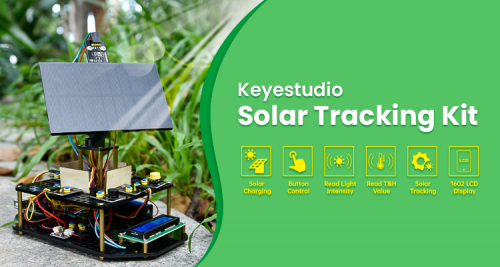KS0530 Keyestudio Solar Tracking DIY Kit for Arduino: Difference between revisions
Keyestudio (talk | contribs) (Created blank page) |
Keyestudio (talk | contribs) No edit summary |
||
| Line 1: | Line 1: | ||
<br>[[File:KS0530-01.png|500px|frameless|thumb]]<br> | |||
==Description== | |||
<br>The solar tracking kit launched by KEYES is based on Arduino. It consists of 4 ambient light sensors, 2 DOF servos, a solar panel and so on, aiming at converting light energy into electronic energy and charging power devices. <br> | |||
<br>It boasts a smart phone charging module, a temperature and humidity sensor, a BH1750 light sensor, a buzzer, an LCD1602 display, a push button module, an LED module and others, enriching the tutorial and making the projects more interesting. <br> | |||
<br>This kit can not only help kids have a better learning about programming but obtain knowledge about electronics, machinery, controlling logic and computer science.<br> | |||
<br>Furthermore, it is a cost-effective open-source programming device. Only a few simple steps are needed to install it and wire it up, very easy and convenient. <br> | |||
<br>There are 11 projects included, from simple to complex, guide you step by step. You can either start from those basic ones like learning how to control a signal module or sensor, or aim at a more sophisticated one, the one integrating most of these components.<br> | |||
<br>What’s more, you can also alter the code or connect it with other sensors or modules through the Lego parts reserved to conduct your own experiments. <br> | |||
<br>Now, let’s embark on an excellent journey together. | |||
==Features== | |||
1.Multiple functions: track light automatically, read temperature, humidity and light intensity, button control, 1602 LCD display and charge by solar energy;<br> | |||
2.Easy to build: insert into Lego jack to install and no need to fix with screws and nuts or solder circuit; also easy to dismantle;<br> | |||
3.Novel style: adopt acrylic boards and copper pillars;sensors or modules connected to acrylic boards via Lego jacks; LCD 1602 modules and solar panels add technologies to it;<br> | |||
4.High extension:preserve IIC, UART, SPI ports and Lego jacks, and extend other sensors and modules;<br> | |||
5.Basic programming : program in C language with Arduino IDE . | |||
==Parameters== | |||
Working voltage: 5v<br> | |||
Input voltage: 3.7V<br> | |||
Maximum output current: 1.5A<br> | |||
Maximum power dissipation: 7.5W | |||
==Kit List== | |||
<br>[[File:KS0530-02.png|500px|frameless|thumb]]<br> | |||
==Resources == | |||
https://fs.keyestudio.com/KS0530 | |||
Revision as of 16:25, 20 August 2021
Description
The solar tracking kit launched by KEYES is based on Arduino. It consists of 4 ambient light sensors, 2 DOF servos, a solar panel and so on, aiming at converting light energy into electronic energy and charging power devices.
It boasts a smart phone charging module, a temperature and humidity sensor, a BH1750 light sensor, a buzzer, an LCD1602 display, a push button module, an LED module and others, enriching the tutorial and making the projects more interesting.
This kit can not only help kids have a better learning about programming but obtain knowledge about electronics, machinery, controlling logic and computer science.
Furthermore, it is a cost-effective open-source programming device. Only a few simple steps are needed to install it and wire it up, very easy and convenient.
There are 11 projects included, from simple to complex, guide you step by step. You can either start from those basic ones like learning how to control a signal module or sensor, or aim at a more sophisticated one, the one integrating most of these components.
What’s more, you can also alter the code or connect it with other sensors or modules through the Lego parts reserved to conduct your own experiments.
Now, let’s embark on an excellent journey together.
Features
1.Multiple functions: track light automatically, read temperature, humidity and light intensity, button control, 1602 LCD display and charge by solar energy;
2.Easy to build: insert into Lego jack to install and no need to fix with screws and nuts or solder circuit; also easy to dismantle;
3.Novel style: adopt acrylic boards and copper pillars;sensors or modules connected to acrylic boards via Lego jacks; LCD 1602 modules and solar panels add technologies to it;
4.High extension:preserve IIC, UART, SPI ports and Lego jacks, and extend other sensors and modules;
5.Basic programming : program in C language with Arduino IDE .
Parameters
Working voltage: 5v
Input voltage: 3.7V
Maximum output current: 1.5A
Maximum power dissipation: 7.5W

